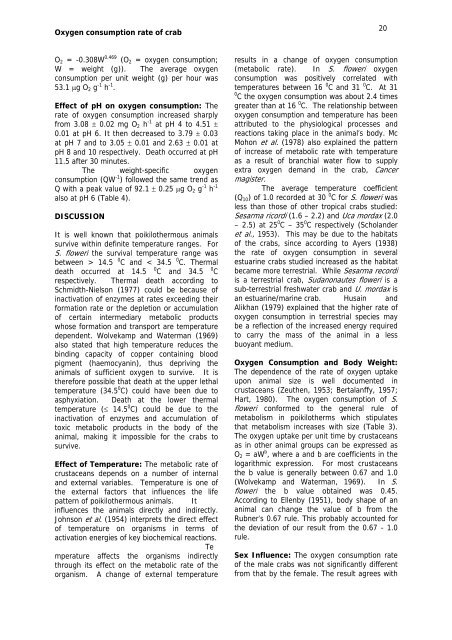Length-weight relationship of fishes from Anambra ... - Zoo-unn.org
Length-weight relationship of fishes from Anambra ... - Zoo-unn.org
Length-weight relationship of fishes from Anambra ... - Zoo-unn.org
- No tags were found...
Create successful ePaper yourself
Turn your PDF publications into a flip-book with our unique Google optimized e-Paper software.
Oxygen consumption rate <strong>of</strong> crab20O 2 = -0.308W 0.469 (O 2 = oxygen consumption;W = <strong>weight</strong> (g)). The average oxygenconsumption per unit <strong>weight</strong> (g) per hour was53.1 µg O 2 g -1 h -1 .Effect <strong>of</strong> pH on oxygen consumption: Therate <strong>of</strong> oxygen consumption increased sharply<strong>from</strong> 3.08 ± 0.02 mg O 2 h -1 at pH 4 to 4.51 ±0.01 at pH 6. It then decreased to 3.79 ± 0.03at pH 7 and to 3.05 ± 0.01 and 2.63 ± 0.01 atpH 8 and 10 respectively. Death occurred at pH11.5 after 30 minutes.The <strong>weight</strong>-specific oxygenconsumption (QW -1 ) followed the same trend asQ with a peak value <strong>of</strong> 92.1 ± 0.25 µg O 2 g -1 h -1also at pH 6 (Table 4).DISCUSSIONIt is well known that poikilothermous animalssurvive within definite temperature ranges. ForS. floweri the survival temperature range wasbetween > 14.5 0 C and < 34.5 0 C. Thermaldeath occurred at 14.50 C and 34.50 Crespectively. Thermal death according toSchmidth-Nielson (1977) could be because <strong>of</strong>inactivation <strong>of</strong> enzymes at rates exceeding theirformation rate or the depletion or accumulation<strong>of</strong> certain intermediary metabolic productswhose formation and transport are temperaturedependent. Wolvekamp and Waterman (1969)also stated that high temperature reduces thebinding capacity <strong>of</strong> copper containing bloodpigment (haemocyanin), thus depriving theanimals <strong>of</strong> sufficient oxygen to survive. It istherefore possible that death at the upper lethaltemperature (34.5 0 C) could have been due toasphyxiation. Death at the lower thermaltemperature (≤ 14.5 0 C) could be due to theinactivation <strong>of</strong> enzymes and accumulation <strong>of</strong>toxic metabolic products in the body <strong>of</strong> theanimal, making it impossible for the crabs tosurvive.Effect <strong>of</strong> Temperature: The metabolic rate <strong>of</strong>crustaceans depends on a number <strong>of</strong> internaland external variables. Temperature is one <strong>of</strong>the external factors that influences the lifepattern <strong>of</strong> poikilothermous animals. Itinfluences the animals directly and indirectly.Johnson et al. (1954) interprets the direct effect<strong>of</strong> temperature on <strong>org</strong>anisms in terms <strong>of</strong>activation energies <strong>of</strong> key biochemical reactions.Temperature affects the <strong>org</strong>anisms indirectlythrough its effect on the metabolic rate <strong>of</strong> the<strong>org</strong>anism. A change <strong>of</strong> external temperatureresults in a change <strong>of</strong> oxygen consumption(metabolic rate). In S. floweri oxygenconsumption was positively correlated withtemperatures between 16 0 C and 31 0 C. At 310 C the oxygen consumption was about 2.4 timesgreater than at 16 0 C. The <strong>relationship</strong> betweenoxygen consumption and temperature has beenattributed to the physiological processes andreactions taking place in the animal’s body. McMohon et al. (1978) also explained the pattern<strong>of</strong> increase <strong>of</strong> metabolic rate with temperatureas a result <strong>of</strong> branchial water flow to supplyextra oxygen demand in the crab, Cancermagister.The average temperature coefficient(Q 10 ) <strong>of</strong> 1.0 recorded at 30 0 C for S. floweri wasless than those <strong>of</strong> other tropical crabs studied:Sesarma ricordi (1.6 – 2.2) and Uca mordax (2.0– 2.5) at 25 0 C – 35 0 C respectively (Scholanderet al., 1953). This may be due to the habitats<strong>of</strong> the crabs, since according to Ayers (1938)the rate <strong>of</strong> oxygen consumption in severalestuarine crabs studied increased as the habitatbecame more terrestrial. While Sesarma recordiis a terrestrial crab, Sudanonautes floweri is asub-terrestrial freshwater crab and U. mordax isan estuarine/marine crab. Husain andAlikhan (1979) explained that the higher rate <strong>of</strong>oxygen consumption in terrestrial species maybe a reflection <strong>of</strong> the increased energy requiredto carry the mass <strong>of</strong> the animal in a lessbuoyant medium.Oxygen Consumption and Body Weight:The dependence <strong>of</strong> the rate <strong>of</strong> oxygen uptakeupon animal size is well documented incrustaceans (Zeuthen, 1953; Bertalanffy, 1957;Hart, 1980). The oxygen consumption <strong>of</strong> S.floweri conformed to the general rule <strong>of</strong>metabolism in poikilotherms which stipulatesthat metabolism increases with size (Table 3).The oxygen uptake per unit time by crustaceansas in other animal groups can be expressed asO 2 = aW b , where a and b are coefficients in thelogarithmic expression. For most crustaceansthe b value is generally between 0.67 and 1.0(Wolvekamp and Waterman, 1969). In S.floweri the b value obtained was 0.45.According to Ellenby (1951), body shape <strong>of</strong> ananimal can change the value <strong>of</strong> b <strong>from</strong> theRubner’s 0.67 rule. This probably accounted forthe deviation <strong>of</strong> our result <strong>from</strong> the 0.67 - 1.0rule.Sex Influence: The oxygen consumption rate<strong>of</strong> the male crabs was not significantly different<strong>from</strong> that by the female. The result agrees with

















